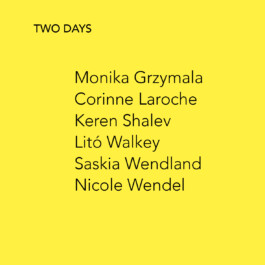
November 15-16, 2025
TWO DAYS
Monika Grzymala
Corinne Laroche
Keren Shalev
Litó Walkey
Saskia Wendland
Nicole Wendel
Saturday, 15.11.2025
Sunday, 16.11.2025
2 – 6 pm
Reading
by Litó Walkey
Sunday, 16.11.2025
4 pm
Studio Nicole Wendel
Kühnemannstraße 51
13409 Berlin
Main building
Second floor
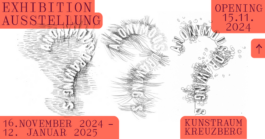
November 16, 2024 – January 12, 2025
The exhibition ANONYMOUS DRAWINGS 2024 features roughly 1000 drawings by 1000 international artists. The works are presented with no mention of authorship or title and offered for sale at a symbolic price of 250€ each. The identity of the artist is revealed only after the work is sold: Sold drawings will be taken right off the wall and the empty space left behind will be marked with the artist‘s full name and place of origin.
ANONYMOUS DRAWINGS is conceptual art and an exhibition project all in one: the works of the participating artists become part of a large wall installation; a hierarchy-free homage to the diverse medium of drawing.
The exhibition was preceded by an international open call for entries. There were no requirements in terms of content or form. The only requirement was that the submitted drawing is no bigger than A3. Age, biography or gender of the artists were not requested and did not play any role in the anonymous selection process. The exhibited drawings were selected from over 4400 submissions by the artist and project founder Anke Becker. All the drawings were put together in collaboration with the artists Veronike Hinsberg and Inken Reinert to create a collective work of art.
Parallel to the exhibition of ANONYMOUS DRAWINGS, the project LINES FICTION will present an extensive series of animated short films by international artists.
KUNSTRAUM KREUZBERG
Mariannenplatz 2
10997 Berlin
Germany
Opening hours
Sundays to Wednesdays, 10 am – 8 pm
Thursdays to Saturdays, 10 am – 10 pm
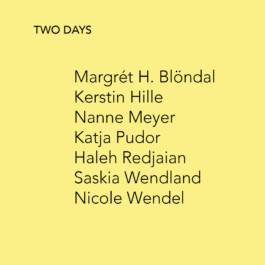
September 21–22, 2024
TWO DAYS
Margrét H. Blöndal
Kerstin Hille
Nanne Meyer
Katja Pudor
Haleh Redjaian
Saskia Wendland
Nicole Wendel
Live Practice (Hybrid)
Nicole Wendel with Emma Cocker
Saturday, September 21, 2024, 5pm
Studio Nicole Wendel
Kühnemannstraße 51
13409 Berlin
Germany
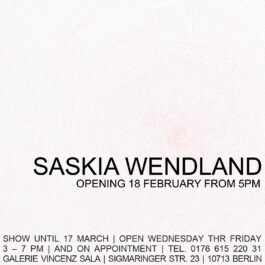
February 18 – March 18, 2023
The circle has some prominence in Saskia Wendland's drawing work. Not only as a recurring form, but also as a performative act of circling, as a physical, form-giving action. The series of red circles measuring the swing of her arms, which over the past 20 years has grown to 26 drawings, may already stand for this. However, Wendland's circling and circling back to form and line by no means always ends up in a circle. Also, the obvious reference to the Ensō of Japanese caligraphy is as evident as misleading. Wendland studied caligraphy during a two-year stay in Japan in the early 2000s. Though, this encounter did not stop at the appropriation of a cultural and artistic practice closely related to Zen Buddhism.
Wendland is not in the first place concerned with the moment and the ritualized act of drawing a circle, which may result in the Ensō. Nor is it about Japanese ink and paper. Wendland works with pencil and cardboard, and her handling of these materials repeatedly brings her drawing work close to minimalist sculpture. Her drawing is work in space. A space she ultimately shares with the viewer.
Above all, Wendland circles back. The first circle is followed by many others in a self-imposed work rhythm. These circles, superposed one upon the other, leave after weeks and months of practice an almost pasty path of the abrasion of the red pencil. It is a repeating and returning, a practicing and insisting, a constant circling back that only much later comes to a close, finding a peculiar conciseness. A conciseness that owes itself to the condensation of time, of action, and finally of the space of her artistic activity.
This persistence and insistence, this slow, sometimes hesitant circling, is present in a different but similar way in all her works. For instance in her dotted circles, which are also on show. Here it is the plan executed with a fineliner that is at the core of the drawing and presents itself with all the care of its execution. Still a physical, performative drawing, but yet entirely without the arm-waving or otherwise sweeping gesture. Works that ultimately show how the encounter with the other is above all an experience and learning of oneself. Perhaps for Wendland in particular the insight into the time it takes, the slowness of the beat that determines the choreography of her drawing.
Even beyond the circular form, Wendland's drawing is about grasping what she does, about the physical and visual knowledge of form and the formal aspects of her work. Which of course includes the act of drawing and her often enduring performance. Once again, Wendland's drawing is slow, aimed at a physical and visual knowledge. Not just of the form, but also of the movement that finds the form and follows it. With its slow choreography that rhymes with seriousness and work, her drawings achieves iconic conciseness that fixes and fixes us.
From Walter Benjamin (quoting Franz Hessel) we know, "We only see what is looking at us." Wendland's drawings look at us. Not as a recording of some intense act of drawing. What is looking at us and what we see is slow time condensed in the beat of work and life.
Galerie Vincenz Sala
Sigmaringer Str. 23
10713 Berlin
Opening hours
Wed–Fri, 3–7 pm
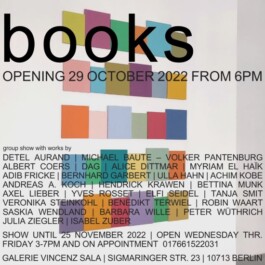
October 29 – November 25, 2022
books
Artists: DETEL AURAND | MICHAEL BAUTE – VOLKER PANTENBURG | ALBERT COERS | DAG I ALICE DITTMAR | MYRIAM EL HAÏK | ADIB FRICKE | BERNHARD GARBERT | ULLA HAHN | ACHIM KOBE | ANDREAS A. KOCH | HENDRICK KRAWEN | BETTINA MUNK | AXEL LIEBER I YVES ROSSET | ELFI SEIDEL | TANJA SMIT | VERONIKA STEINKOHL | BENEDIKT TERWIEL | ROBIN WAART | SASKIA WENDLAND | BARBARA WILLE | PETER WÜTHRICH | JULIA ZIEGLER | ISABEL ZUBER
From a curatorial point of view, there is not much more to say about 'books' than the exhibition title already says. Though, our interest in the subject has a long and rich history. With 'books', it culminates in the presentation of a wide range of most diverse artistic approaches to the book as object, medium and technology. The approach of the opening date has led to one thing in particular: The successive grinding of any remaining programmatic border fortifications. Thus the show gathers bookworks engaging across all genres and beyond. Rather classical artist's books, sketchbooks and leporellos, some from the late 80s and 90s, are included, but also sculptural, installative and conceptual works, a book on a movie and the movie on the book and a website: https://adibfricke.com/die-reise/
We would note, though: The metaphorical reference in that idiomatic expression of 'devouring a book' already points to an ambivalence in the reading of books that often gets even somewhat rougher in the artistic work with books. The bibliophilic pleasure has its counterpart. "... Not that you mind the killings. Your book is full of killings ..." says Harry Paul (Robert Michum), the serial killer in Charles Laughton's 'The night of the hunter'. (Minutentexte, the book to the film edited by Michael Baute and Volker Pantenburg and the corresponding film to the book also appear in the side programme of the show). In the artistic production, the book sets the scene for many battles and atrocities. It is cut up, sliced, skeletonized, glued, and, if necessary, provided with a holes in the back for the nail on which it is to hang. With such forms of appropriation and incorporation, there is not much left of the book to read. However, the sensual, bibliophilic experience that the book offers only really becomes apparent with this material battle.
And then: Where one's own working through and digestion of 'important' books in a fairly distant past couldn't help some heavy underlining with a pencil, and later on maltreating the book with neon yellow, green and pink markers, the artist's reading of the book by times completely derails. Inspired by the content, but perhaps even more so by the printed page, the linear clatter of letters and words, the book undergoes much more than a 'working through'. It is transformed into a new, graphically complex state that opens up a new, very different life after the 'read out'.
Finally: The book as the setting for such adventures finally becomes, in a more unadulterated bibliophilic apprehension, the book as time. Experienced time; time captured in photos, sketches, documents; but also the time of book creation and book leafing. With the technology of the book artistic work and its reception enters into the order of backwards and forwards. An order of successive pages to which sketches, photographs, drawings and collages between the covers of the book necessarily conform, even if they resist it. The book is not in the first place an image, but a sequence of images: Film.
And then you close the book, put it back on the shelf and remember.
P.S. Speaking of film, we filmed almost all of the books on display and posted the films on the website linked here: https://www.vsala.com/books.html One or two exhibits remain to be added.
Galerie Vincenz Sala
Sigmaringer Str. 23
10713 Berlin
Openinng hours
Wed–Fri, 3–7 pm

September 3 – October 30, 2022
Worin unsere Stärke besteht
Curated by Andrea Pichl
Curatorial assistance: Sylvia Sadzinski
Artists: Tina Bara, Ina Bierstedt, Antje Blumenstein, Peggy Buth, Nadja Buttendorf, Yvon Chabrowski, Annedore Dietze, Künstlerinnengruppe Erfurt, Else Gabriel, Katrin Glanz, Henriette Grahnert, Jana Gunstheimer, Sabine Herrmann, Elke Hopfe, Margret Hoppe, Beate Hornig, Uta Hünniger, Lisa Junghanß, Christina Kral, Betina Kuntzsch, Ulrike Kuschel, Alex Lebus, Ingeborg Lockemann, Wiebke Loeper, Jana Müller, Ulrike Mundt, Henrike Naumann/Susanne Rische, Helga Paris, Andrea Pichl, Katja Pudor, Franziska Reinbothe, Inken Reinert, Sabine Reinfeld, Sophie Reinhold, Ricarda Roggan, Jenny Rosemeyer, Christine Schlegel, Luise Schröder, Wenke Seemann, Gabriele Stötzer, Erika Stürmer-Alex, Anett Stuth, Ulrike Theusner, Manuela Warstat, Suse Weber, Saskia Wendland, Kristin Wenzel, Eva Wilde, Karla Woisnitza/Ingartan und Ruth Wolf-Rehfeldt
The exhibition Worin unsere Stärke besteht (“Where our strength lies”), curated by artist Andrea Pichl, shows the work of fifty women artists from three different generations who were born in the GDR (German Democratic Republic). Working with different media and diverse genres, the artists investigate complex themes, producing works that defy categorisation, and that cannot be reduced to a single aesthetic or subject. Some of the artists were already active during the GDR period. The exhibition does not address any narrative relating to the GDR, nor does it historicise art from the GDR. Rather, it opens out to artists’ biographies, approaching the question of how lived experience influences artistic thematic preoccupations. A small number of the works exhibited were produced during the GDR period.
The exhibition is accompanied by a program of events and a collection of texts.
Kunstraum Kreuzberg/Bethanien
Mariannenplatz 2
10997 Berlin
Openinng hours
Sun–Mon, 10am – 8pm
Thu–Sat, 10am – 10pm
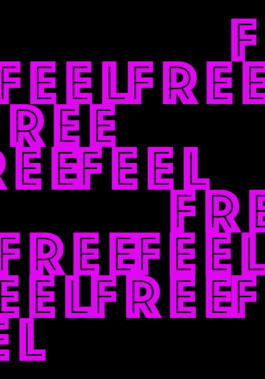
August 26 – September 24, 2022
FEEL FREE
Curated by Lisa Junghanß
Artists: Olivia Berckemeyer, Charlotte Bastian, Antje Blumenstein, Barbara Breitenfellner, Laura Bruce, Jonas Burgert, Max Dax, Martin Eder, Tine Furler, Axel Geis, Beate Gütschow, Gregor Hildebrandt, Sabine Hornig, Sofia Hultén, Jeroen Jacobs, Lisa Junghanß, Andreas Koch, Julia Krewani, Joep van Liefland, Catherine Lorent, Karla Marchesi, Frank Nitsche, Nik Nowak, Justine Otto, Manfred Peckl, Cornelia Renz, Jenny Rosemeyer, Anselm Reyle, Gerwald Rockenschaub, Sophia Schama, Thomas Scheibitz, Erik Schmidt, Andreas Slominski, Natascha Stellmach, Katja Strunz, Moritz Stumm, Corinne Wasmuht, Bettina Weiß, Saskia Wendland, Tilman Wendland, Mo Whiteman
SCOTTY
Raum für zeitgenössische Kunst und experimentelle Medien
Oranienstrasse 46
10969 Berlin
Exhibition duration: August 26 – September 24,2022
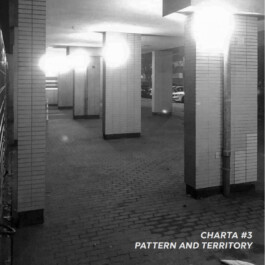
May 13 – June 11, 2022
CHARTA#3
Artists: Leon Manoloudakis, Saskia Wendland, Nadine Fecht, Larissa Fassler, Willem Besselink
Curators: Jan-Philipp Frühsorge, Stephan Klee
Curatorial assistance: Matteo Lorrusso
Kluckstraße 23 A
10785 Berlin
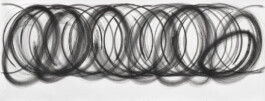
DECEMBER 4–26, 2021
Inclusive Break – A Time Beside Many Others
Artists: Shan GAO, Stella Geppert, Qing KANG, Nicole Wendel, Saskia Wendland, Yinchen ZHOU
Academic Advisor: Iris Dankemeyer, Junlei YANG
Curator: Ting ZHANG
Organizer: Liu Haisu Art Museum, Department of Culture and Education of the Consulate General of the Federal Republic of Germany in Shanghai
Special Thanks to: Dr. Oliver Hartmann, Xingcheng SHEN, Ting ZHANG and Iris Dankemeyer, Junlei YANG
Shanghai
Now a year later. From December 3 to 26, 2021, an artistic chapter co-choreographed by China and Germany will open once again at Liu Haisu Art Museum. After two years of preparation, the exhibition under the title of Inclusive Break – A Time Beside Many Others - a longer and more extensive version of the pop-up event - co-organized by Liu Haisu Art Museum and the Department of Culture and Education of the German Consulate General Shanghai will be on view for nearly a month-long period. The exhibition will feature six artists including Kang Qing, Gao Shan and Zhou Yinchen from China and Stella Geppert, Nicole Wendel and Saskia Wendland from Germany. Collectively they present the audience in Shanghai nearly 100 pieces of work from 33 groups, including action painting, sculptural installation, performance video, drawing and archival material.
A “break” may refer to a breath of exhalation and inhalation or a sensory journey from now to then. “Inclusive break” on the one hand casts light on how people govern time in their social work (production) and life (consumption); and on the other, reflects artists’ inquiries into the different forms and states of time. What does time mean to artistic creation? At what point of time does artistic practice begin? How do we feel the passing of time at the scene through artworks? How to overcome the time difference in cross-national artistic dialogue? How to achieve synchronic and effective equilibrium through the mutual relationship of culture? The title of the exhibition concentrates on an ephemeral moment, attempting to ignite the passion for philosophical reflection. In the two years of uninterrupted creative exchange and academic discussion, two philosophers Yang Junlei from Shanghai, Iris Dankemeyer from Berlin and Shanghai-based curator Zhang Ting observe the words “inclusive” and “break” in such a rich, extensive and subtle way, and provide the artists with tremendous impetus and strategies for their creative cross-cultural dialogue. Apart from the exhibition, all the brain work based on perception and thinking has also been presented in a variety of online forms, including “Media Takeover”, “Sino-German 60 Seconds”, an online academic marathon and “Long-Distance Visits”, which cast more and further light on how the six artists have managed to shift towards a profoundly “slow-down” manner of working under the backdrop of the pandemic and to probe into time and temporality.
Inclusive Break – A Time Beside Many Others, as an unusual international exchange project that has covered a long time span under a highly unique context, manages to attain self-adaptivity through constantly adjustments of methodologies. The brand new gestures and profound academic thinking demonstrated are achieved through the joint efforts of the organizers in China and Germany, curator, artists and philosophers, which is in fact one of the most intriguing and charming elements of the project. We look forward to setting our foot at the exhibition scene again to invite audience to immerse themselves in the art from the remarkable artists from the two countries, to gain insights into how they ignite the vision of art through the moments that illuminate life, and to experience the sharing, empathy and integration of the community of shared future for mankind.
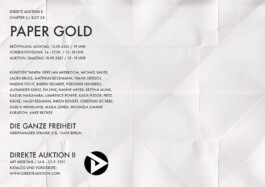
SEPTEMBER 13–17, 2021
PAPER GOLD
DIREKTE AUKTION IICHAPTER 5 / SLOT 24
Artists: Gert-Jan Akerboom, Michael Bause, Laura Bruce, Matthias Beckmann, Frank Diersch, Nadine Fecht, Bjørn Hegardt, Veronike Hinsberg, Alexander Klenz, Pia Linz, Nanne Meyer, Bettina Munk, Kazuki Nakahara, Lawrence Power, Katja Pudor, Fritz Räcke, Haleh Redjaian, Inken Reinert, Christian Schiebe, Saskia Wendland, Majla Zeneli, Michaela Zimmer
Curator: Anke Becker
Greifswalder Str. 218
10405 Berlin
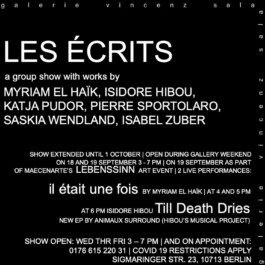
AUGUST 21 – OCTOBER 1, 2021
“Writing is drawing” says Tim Ingold (in 'Lines'). Of course, an important reference for the selection of drawings on show at 'Les Écrits' (after 'Verzeichnen' (end of 2019) and 'traumatic lines' (August 2020) the third and final edition of our trilogy of group shows on the extended field of drawing). However, the reference to Ingold, and also the exhibition title, leads astray in one respect: there is nothing to read! One may be able here and there to decipher a word or perhaps a brief sentence (e.g. Katja Pudor, Saskia Wendland). And more generally all the exhibited drawings have a typeface, are handwritten drawings (Isabel Zuber, Myriam El Haïk, and also Pierre Sportolaro's rather more seismographic recordings of a flight from Berlin to Paris). However, they lack the significance that is essential for writing. They are not text, and only rarely a readable word or short sentence shows up. Thus, whilst 'Les Écrits' provides ample evidence for Ingold's “writing is drawing” there is no drawing that would suggest an “… is writing”.
“Reading” these handwritten drawings must do without much linguistic meaning. It’s writing on this side of language and of the order of the symbolic. Writing in the realm of the allographic. Some sort of, obviously autographic, signature, though, not even bothered to put a name. Nelson Goodman (‘Languages of Art’) discussed at some length the distinction between the autographic and the allographic, emphasizing that for the latter the formal properties of what’s written are contingent, irrelevant for the meaning. Whether ink, pencil, or felt-tip pen, the color, size, and shape of the letters, all of these features are redundant. And the works presented at 'Les Écrits' offer nothing but that. Thus, the viewer is pushed to follow, above all, the physical act of writing as recorded in the written drawing. It's again drawing as a purely performative act, as doing, in some cases almost doing nothing (Sportolaro) and finally simply waiting (Isidore Hibou's 'Till Death Dries').
However, the viewer is well equipped for this kind of reading. Having undergone himself the lengthy and laborious exercise of learning to write is there to help. It’s in the dimension of the physical, of the own hand conditioned by that exercise of learning to write, that the viewer relates to these works. A kind of bodily tracing of the recorded act of writing in the shared world of the fine motor skills of the hand. A tuning in and resonating that refers to the automatisms ingrained in the viewer’s body and procedural memory. And one wonders how Roland Barthes' famous question about the romantic ‘Lied’ would have to be reformulated for this kind of drawing. The question was: "What sings to me, who hears, in my body the song?"
Sigmaringer Strasse 23
10713 Berlin
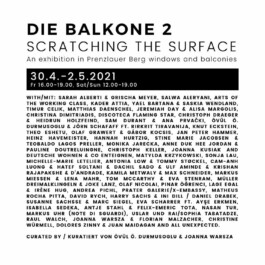
APRIL 30 – MAY 2, 2021
Die Balkone 2 – Scratching the Surface
An exhibition in Prenzlauer Berg windows and balconies
Sarah Alberti & Grischa Meyer, Salwa Aleryani, Arts of the Working Class, Kader Attia, Yael Bartana & Saskia Wendland, Adam Broomberg, Timur Celik, Matthias Daenschel, Jeremiah Day & Alisa Margolis, Christina Dimitriadis, discoteca flaming star, Christoph Draeger & Heidrun Holzfeind, Sam Durant & Ana Prvački, Övül Ö. Durmusoglu & Jörn Schafaff ft. Rirkrit Tiravanija, Knut Eckstein, Theo Eshetu, Olaf Grawert & Gábor Kocsis, Jan Peter Hammer, Heinz Havemeister, Hannah Hurtzig & Hasan Aksaygin, Stine Marie Jacobsen & Teobaldo Lagos Preller, Monika Jarecka, Anne Duk Hee Jordan & Pauline Doutreluingne, Christoph Keller, Joanna Kusiak and Deutsche Wohnen & Co Enteignen, Matylda Krzykowski, Sonja Lau, Michelle-Marie Letelier, Antonia Low & Tommy Støckel, Cam-Anh Luong & Hatef Soltani & Dachil Sado & Ulf Aminde & Krishan Rajapakshe & D’Andrade, Kamila Metwaly & Max Schneider, Markus Miessen & Lena Mahr, Tom McCarthy & Eva Stenram, Müller Dreimalklingeln & Joke Lanz, Olaf Nicolai, Pınar Öğrenci, LAGE EGAL & Irène Hug, Andrea Pichl, Prater Galerie/x-embassy, Matheus Rocha Pitta, David Rych, Harry Sachs & Ini Dill / Daniel Drabek, Susanne Sachsse & Marc Siegel, Eva Scharrer ft. Ayşe Erkmen, Isabella Sedeka, Antje Stahl & Felix-Emeric Tota, Nasan Tur, Markus Uhr (Note di Sguardi), Uslar und Rai/Sophia Tabatadze, Raul Walch, Michael John Whelan, Christine Würmell, Dolores Zinny & Juan Maidagan and all unexpected.
Curated by Övül Ö. Durmusoglu & Joanna Warsza
www.diebalkone.net
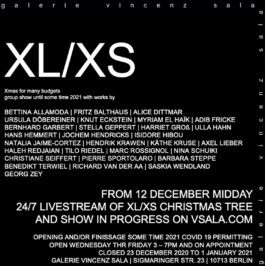
DECEMBER 12, 2020 – SOME TIME IN 2021
XL/XS
xmas group show for many budgets with works by:
Bettina Allamoda, Fritz Balthaus, Alice Dittmar, Ursula Döbereiner, Knut Eckstein, Myriam El Haïk, Adib Fricke, Bernhard Garbert, Stella Geppert, Harriet Groß, Ulla Hahn, Hans Hemmert, Jochem Hendricks, Isidore Hibou, Marianna Ignataki, Natalia Jaime-Cortez, Hendrik Krawen, Käthe Kruse, Axel Lieber, Christiane Seiffert, Haleh Redjaian, Tilo Riedel, Marc Rossignol, Nina Schuiki, Pierre Sportolaro, Barbara Steppe, Benedikt Terwiel, Richard van der Aa, Saskia Wendland, Georg Zey
Open: on appointment only (0176 615 220 31)
Galerie Vincenz Sala
Sigmaringer Str. 23
10713 Berlin
Instagram #galerievincenzsala
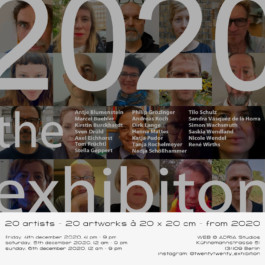
DECEMBER 4–6, 2020
2020 – the exhibition
20 artists, 20 artworks, each 20 × 20 cm, from 2020
Antje Blumenstein, Marcel Buehler, Kirstin Burckhardt, Sven Drühl, Axel Eichhorst, Tom Früchtl, Stella Geppert, Philip Grözinger, Andreas Koch, Dirk Lange, Hanna Mattes, Katja Pudor, Tanjy Rochelmeyer, Nadja Schöllhammer, Tilo Schulz, Sandra Vásquez de la Horra, Simon Wachsmuth, Nicole Wendel, Saskia Wendland, René Wirths
WEB / ADRIA
Kühnemannstraße 51
(nahe S-Bhf Wollankstraße)
Instagram #twentytwenty_exhibition
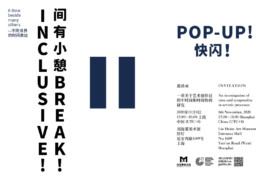
NOVEMBER 8, 2020
POP-UP
Inclusive Break – A time beside many others
An investigation of time and temporality in artistic processes
An art project between Shanghai based artists Kang Qing, Gao Shan and Zhou Yinchen, and the Berlin based artists Stella Geppert, Nicole Wendel and Saskia Wendland, in dialogue with the philosophers Yang Junlei and Iris Dankemeyer, curated by Zhang Ting.
In cooperation with Liu Haisu Art Museum and Department of Culture and Education of the Consulate General of the Federal Republic of Germany in Shanghai.
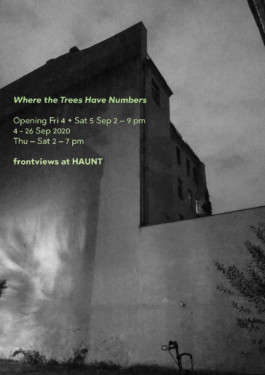
SEPTEMBER 4–26, 2020
Where the Trees Have Numbers
Dafni Barbageorgopoulou, Carsten Becker, Willem Besselink, Mit Borrás, Kirstin Burckhardt, Timo Herbst, Bretz / Holliger, Despina Flessa, Stella Geppert, Marianna Ignataki, Pius Fox, Thorsten Alexander Kasper, Marc Klee, Kathrin Köster, Alana Lake, Leon Manoloudakis, Katja Pudor, Nicole Wendel, Saskia Wendland, Tilman Wendland
curated by Jan-Philipp Frühsorge
When looking for street names, house numbers or other bits and pieces of useful information in urban spaces, the eye of the searcher occasionally lingers over the numbers on the trunks of the trees. Kept small, but colourful and striking, the engraved numbers on the bark easily catch the eye. The different shapes, colours and sizes of the numbered plaques represent a complex cadastral system; most city dwellers lack the key to decipher the colonnades of numbers. Employees of Berlin's Green Spaces Office are familiar with the information and maintenance of the plaque system. It is an important tool to categorise, manage and control urban plant growth.
The exhibition Where the Trees Have Numbers takes place in the pavilion of the former training rooms of the Grünflächenamt Mitte/Tiergarten. For over six years, the site was unused, empty and free of human activity. Nature made use of time and has gradually, mischievously and freely spread out on the area of its former masters, following the motto ‚Who has the longer breath’? Thus the ensemble of pavilion, workrooms, garden, courtyard and patio in its present state tells not only of the interplay of generative drive and structural control, but also of letting go and the flow of time in an urban context.
The renewed human activity, started by the artists, curators and theorists of frontviews, brought about the name HAUNT for the complex; a name that ties together its history and its new purpose. HAUNT exists as an exhibition space for contemporary European art. A lot has happened in the past years and months. Therefore, a new approach, a new modus operandi has been added, namely the collective findings way to address our current states of emergency. How do we deal with this, how can we come together and keep each other safe? How do we reflect on the upheaval and develop an awareness for the new necessities coming into play? Perhaps it is about letting go of old certainties, and about the loss of control and meaning. If this is the case, how can we let things flourish freely? The aim is not to decelerate various wellness concepts, but rather to find an alternative way of dealing with our time, because as Byung-Chul Han remarks: ’What is necessary today is not deceleration, but a time revolution that allows a completely different time to begin’.
In light of this new era, Berlin’s art scene seems to be transforming too, therefore HAUNT exists as a space for exploring these new potentials. Where the Trees Have Numbers is the first official group exhibition of the collective (where all current members will present works) – thus the first field is marked out and every participant will become visible.
frontviews at HAUNT
Kluckstraße 23
10785 Berlin
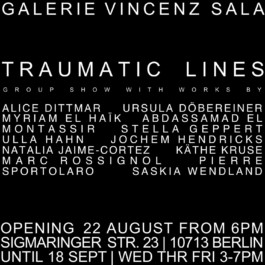
AUGUST 22 – SEPTEMBER 27, 2020
Traumatic Lines
with works by Alice Dittmar, Ursula Döbereiner, Abdessamad El Montassir, Myriam El Haïk, Stella Geppert, Jochem Hendricks, Natalia Jaime-Cortez, Käthe Kruse, Ulla Hahn, Marc Rossignol, Pierre Sportolaro, Saskia Wendland
The exhibition proposes a linking of the works on show focusing on the variety of ways they bring layers and levels of the physical into play. The pen that draws, and what in some of the works replaces that pen, becomes a tool that not just draws but also scratches, stitches, and cuts; that becomes part of a process engaging the body, pushing and pulling it into the center of the artistic events. A body that, probably more than anything else, incurs the drawing, is exposed to and befallen by it. Obviously not just the body of the work, the picture base. The physical assault is also incurred at the other end of the pen. The hand that draws has been physically shaped by the backbreaking repetition of letters, by this physical conditioning necessary to learn the craft of writing. The automatisms in the developed fine motor skills of that trained hand imply forms of control where in many respects the conscious and even the unconscious have not much of a say anymore. Some immediate physical authority is in command, and not just of that trained hand that doesn't write anymore, that is even in some of the works replaced by prostheses (Hendrick's eye-scanner, by the way this time recording the reading of the first page of Freud’s Traumdeutung, Geppert's headsets, Kruse's sewing machine). The drawing happens, is incurred, informed by some choreography (Geppert, Rossignol), or a ritual (Wendland’s big circle, Hahn), or just a set of simple rules (Dittmar, Döbereiner, El Haïk, Jaime-Cortez, Wendland). In particular minimalist repetition by times to the point of physical exhaustion is at work: Hatching for large and small formats in Döbereiner’s and Dittmar’s work; Wendland's small circle of countless, meticulously set points; El Haik's interweaving of equally countless stylized Arabic characters; and also Hendrick’s egg-formed glass bowl with the literally counted (!) 10,258,743 grains of sand in it. An exhausting, self-forgotten and self-remembering repetition, for which in some way Sportolaro's glowing heating rod may stand. You can watch it through a recessed window, orange-glowing in a freezer compartment, melting the ice until the built-in temperature controller switches the current from the rod to the freezer’s heat pump; which in turn, due to the falling temperature in the freezer compartment, switches the current back to the heating rod; and so on. A slow loop drawing the viewer to engage and not just watch but literally sense the never-ending small-scale drama of that fight between the heating rod and the freezer’s heat pump.
Galerie Vincenz Sala
Sigmaringer Str. 23
10713 Berlin
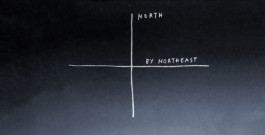
NORTH BY NORTHEAST
A graphic-performative dialogue in which the relationship between movement, space and time is reframed by the line
Initiated by Katja Pudor and Nicole Wendel
With works by Nikolaus Gansterer, Stella Geppert, Katja Pudor, Christian Schellenberger, Nicole Wendel and Saskia Wendland
The exhibition sets a course for the elementary forms of drawing. Based on an understanding of the body as an instrument for seismographic recording and as an intelligent storage medium for complex knowledge, »NORTH BY NORTHEAST« explores central issues in drawing: Which stimuli and conditions are relevant for drawing processes? What part do physical action and movement play? What is the role of chance and how is temporality visibly inscribed into the drawing?
In their individual practice, the artists Nikolaus Gansterer, Stella Geppert, Katja Pudor, Christian Schellenberger, Nicole Wendel and Saskia Wendland pursue various performative strategies of logging, recording and archiving. Nikolaus Gansterer, who equates graphic procedures and thought processes, turns a school blackboard into a dynamic resonance chamber for knowledge transfer. Stella Geppert’s constructivist sculptures serve as a framework for social interactions, becoming pictorial spaces for graphic traces of conversations and readings. Katja Pudor continually expands, reorders and overwrites her own drawing-based archive in site-specific installations and performances, creating a layered ›archaeology of the present‹ that reveals various sediments of memories, meanings, and references. Christian Schellenberger transforms encounter and change into large-format cartographies of abstract marks. In her choreographed and improvised work, Nicole Wendel uses shifts between physical and pictorial awareness to explore the relationship between motion in space and the making of a two-dimensional image. In Saskia Wendland’s work, the repetition of identical movement sequences and ritualized processes involving the entire body give rise to clear geometrical shapes resulting from minimalist gestures of line, point, and stroke.
As they meet in the exhibition, the various works allow previous notions of drawing and how drawings are read to be reviewed, encouraging the exploration of unknown forms of graphic notation and provoking an expansion of each artist’s individual repertoire. The exhibition space at the Deutscher Künstlerbund acts as a laboratory where performances, installation and video screenings both examine and demonstrate the performative and processual potential of drawing.
Deutscher Künstlerbund
Markgrafenstraße 67
10969 Berlin
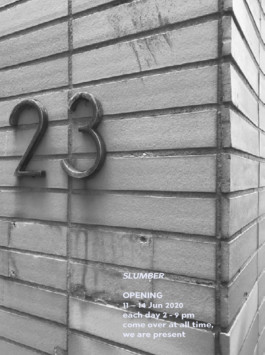
JUNE 11–21, 2020
Slumber
Carsten Becker, Emanuel Bernstone, Willem Besselink, Mit Borrás, Bretz/Holliger, Pius Fox, Stella Geppert, Marianna Ignataki, Thorsten Alexander Kasper, Kathrin Köster, Dennis Meier, Nicole Wendel, Saskia Wendland, Sinta Werner, Michaela Zimmer
frontviews at HAUNT
Kluckstrasse 23
10785 Berlin

November 15-16, 2025
TWO DAYS
Monika Grzymala
Corinne Laroche
Keren Shalev
Litó Walkey
Saskia Wendland
Nicole Wendel
Saturday, 15.11.2025
Sunday, 16.11.2025
2 – 6 pm
Reading
by Litó Walkey
Sunday, 16.11.2025
4 pm
Studio Nicole Wendel
Kühnemannstraße 51
13409 Berlin
Main building
Second floor

November 16, 2024 – January 12, 2025
The exhibition ANONYMOUS DRAWINGS 2024 features roughly 1000 drawings by 1000 international artists. The works are presented with no mention of authorship or title and offered for sale at a symbolic price of 250€ each. The identity of the artist is revealed only after the work is sold: Sold drawings will be taken right off the wall and the empty space left behind will be marked with the artist‘s full name and place of origin.
ANONYMOUS DRAWINGS is conceptual art and an exhibition project all in one: the works of the participating artists become part of a large wall installation; a hierarchy-free homage to the diverse medium of drawing.
The exhibition was preceded by an international open call for entries. There were no requirements in terms of content or form. The only requirement was that the submitted drawing is no bigger than A3. Age, biography or gender of the artists were not requested and did not play any role in the anonymous selection process. The exhibited drawings were selected from over 4400 submissions by the artist and project founder Anke Becker. All the drawings were put together in collaboration with the artists Veronike Hinsberg and Inken Reinert to create a collective work of art.
Parallel to the exhibition of ANONYMOUS DRAWINGS, the project LINES FICTION will present an extensive series of animated short films by international artists.
KUNSTRAUM KREUZBERG
Mariannenplatz 2
10997 Berlin
Germany
Opening hours
Sundays to Wednesdays, 10 am – 8 pm
Thursdays to Saturdays, 10 am – 10 pm

September 21–22, 2024
TWO DAYS
Margrét H. Blöndal
Kerstin Hille
Nanne Meyer
Katja Pudor
Haleh Redjaian
Saskia Wendland
Nicole Wendel
Live Practice (Hybrid)
Nicole Wendel with Emma Cocker
Saturday, September 21, 2024, 5pm
Studio Nicole Wendel
Kühnemannstraße 51
13409 Berlin
Germany

February 18 – March 18, 2023
The circle has some prominence in Saskia Wendland's drawing work. Not only as a recurring form, but also as a performative act of circling, as a physical, form-giving action. The series of red circles measuring the swing of her arms, which over the past 20 years has grown to 26 drawings, may already stand for this. However, Wendland's circling and circling back to form and line by no means always ends up in a circle. Also, the obvious reference to the Ensō of Japanese caligraphy is as evident as misleading. Wendland studied caligraphy during a two-year stay in Japan in the early 2000s. Though, this encounter did not stop at the appropriation of a cultural and artistic practice closely related to Zen Buddhism.
Wendland is not in the first place concerned with the moment and the ritualized act of drawing a circle, which may result in the Ensō. Nor is it about Japanese ink and paper. Wendland works with pencil and cardboard, and her handling of these materials repeatedly brings her drawing work close to minimalist sculpture. Her drawing is work in space. A space she ultimately shares with the viewer.
Above all, Wendland circles back. The first circle is followed by many others in a self-imposed work rhythm. These circles, superposed one upon the other, leave after weeks and months of practice an almost pasty path of the abrasion of the red pencil. It is a repeating and returning, a practicing and insisting, a constant circling back that only much later comes to a close, finding a peculiar conciseness. A conciseness that owes itself to the condensation of time, of action, and finally of the space of her artistic activity.
This persistence and insistence, this slow, sometimes hesitant circling, is present in a different but similar way in all her works. For instance in her dotted circles, which are also on show. Here it is the plan executed with a fineliner that is at the core of the drawing and presents itself with all the care of its execution. Still a physical, performative drawing, but yet entirely without the arm-waving or otherwise sweeping gesture. Works that ultimately show how the encounter with the other is above all an experience and learning of oneself. Perhaps for Wendland in particular the insight into the time it takes, the slowness of the beat that determines the choreography of her drawing.
Even beyond the circular form, Wendland's drawing is about grasping what she does, about the physical and visual knowledge of form and the formal aspects of her work. Which of course includes the act of drawing and her often enduring performance. Once again, Wendland's drawing is slow, aimed at a physical and visual knowledge. Not just of the form, but also of the movement that finds the form and follows it. With its slow choreography that rhymes with seriousness and work, her drawings achieves iconic conciseness that fixes and fixes us.
From Walter Benjamin (quoting Franz Hessel) we know, "We only see what is looking at us." Wendland's drawings look at us. Not as a recording of some intense act of drawing. What is looking at us and what we see is slow time condensed in the beat of work and life.
Galerie Vincenz Sala
Sigmaringer Str. 23
10713 Berlin
Opening hours
Wed–Fri, 3–7 pm

October 29 – November 25, 2022
books
Artists: DETEL AURAND | MICHAEL BAUTE – VOLKER PANTENBURG | ALBERT COERS | DAG I ALICE DITTMAR | MYRIAM EL HAÏK | ADIB FRICKE | BERNHARD GARBERT | ULLA HAHN | ACHIM KOBE | ANDREAS A. KOCH | HENDRICK KRAWEN | BETTINA MUNK | AXEL LIEBER I YVES ROSSET | ELFI SEIDEL | TANJA SMIT | VERONIKA STEINKOHL | BENEDIKT TERWIEL | ROBIN WAART | SASKIA WENDLAND | BARBARA WILLE | PETER WÜTHRICH | JULIA ZIEGLER | ISABEL ZUBER
From a curatorial point of view, there is not much more to say about 'books' than the exhibition title already says. Though, our interest in the subject has a long and rich history. With 'books', it culminates in the presentation of a wide range of most diverse artistic approaches to the book as object, medium and technology. The approach of the opening date has led to one thing in particular: The successive grinding of any remaining programmatic border fortifications. Thus the show gathers bookworks engaging across all genres and beyond. Rather classical artist's books, sketchbooks and leporellos, some from the late 80s and 90s, are included, but also sculptural, installative and conceptual works, a book on a movie and the movie on the book and a website: https://adibfricke.com/die-reise/
We would note, though: The metaphorical reference in that idiomatic expression of 'devouring a book' already points to an ambivalence in the reading of books that often gets even somewhat rougher in the artistic work with books. The bibliophilic pleasure has its counterpart. "... Not that you mind the killings. Your book is full of killings ..." says Harry Paul (Robert Michum), the serial killer in Charles Laughton's 'The night of the hunter'. (Minutentexte, the book to the film edited by Michael Baute and Volker Pantenburg and the corresponding film to the book also appear in the side programme of the show). In the artistic production, the book sets the scene for many battles and atrocities. It is cut up, sliced, skeletonized, glued, and, if necessary, provided with a holes in the back for the nail on which it is to hang. With such forms of appropriation and incorporation, there is not much left of the book to read. However, the sensual, bibliophilic experience that the book offers only really becomes apparent with this material battle.
And then: Where one's own working through and digestion of 'important' books in a fairly distant past couldn't help some heavy underlining with a pencil, and later on maltreating the book with neon yellow, green and pink markers, the artist's reading of the book by times completely derails. Inspired by the content, but perhaps even more so by the printed page, the linear clatter of letters and words, the book undergoes much more than a 'working through'. It is transformed into a new, graphically complex state that opens up a new, very different life after the 'read out'.
Finally: The book as the setting for such adventures finally becomes, in a more unadulterated bibliophilic apprehension, the book as time. Experienced time; time captured in photos, sketches, documents; but also the time of book creation and book leafing. With the technology of the book artistic work and its reception enters into the order of backwards and forwards. An order of successive pages to which sketches, photographs, drawings and collages between the covers of the book necessarily conform, even if they resist it. The book is not in the first place an image, but a sequence of images: Film.
And then you close the book, put it back on the shelf and remember.
P.S. Speaking of film, we filmed almost all of the books on display and posted the films on the website linked here: https://www.vsala.com/books.html One or two exhibits remain to be added.
Galerie Vincenz Sala
Sigmaringer Str. 23
10713 Berlin
Openinng hours
Wed–Fri, 3–7 pm

September 3 – October 30, 2022
Worin unsere Stärke besteht
Curated by Andrea Pichl
Curatorial assistance: Sylvia Sadzinski
Artists: Tina Bara, Ina Bierstedt, Antje Blumenstein, Peggy Buth, Nadja Buttendorf, Yvon Chabrowski, Annedore Dietze, Künstlerinnengruppe Erfurt, Else Gabriel, Katrin Glanz, Henriette Grahnert, Jana Gunstheimer, Sabine Herrmann, Elke Hopfe, Margret Hoppe, Beate Hornig, Uta Hünniger, Lisa Junghanß, Christina Kral, Betina Kuntzsch, Ulrike Kuschel, Alex Lebus, Ingeborg Lockemann, Wiebke Loeper, Jana Müller, Ulrike Mundt, Henrike Naumann/Susanne Rische, Helga Paris, Andrea Pichl, Katja Pudor, Franziska Reinbothe, Inken Reinert, Sabine Reinfeld, Sophie Reinhold, Ricarda Roggan, Jenny Rosemeyer, Christine Schlegel, Luise Schröder, Wenke Seemann, Gabriele Stötzer, Erika Stürmer-Alex, Anett Stuth, Ulrike Theusner, Manuela Warstat, Suse Weber, Saskia Wendland, Kristin Wenzel, Eva Wilde, Karla Woisnitza/Ingartan und Ruth Wolf-Rehfeldt
The exhibition Worin unsere Stärke besteht (“Where our strength lies”), curated by artist Andrea Pichl, shows the work of fifty women artists from three different generations who were born in the GDR (German Democratic Republic). Working with different media and diverse genres, the artists investigate complex themes, producing works that defy categorisation, and that cannot be reduced to a single aesthetic or subject. Some of the artists were already active during the GDR period. The exhibition does not address any narrative relating to the GDR, nor does it historicise art from the GDR. Rather, it opens out to artists’ biographies, approaching the question of how lived experience influences artistic thematic preoccupations. A small number of the works exhibited were produced during the GDR period.
The exhibition is accompanied by a program of events and a collection of texts.
Kunstraum Kreuzberg/Bethanien
Mariannenplatz 2
10997 Berlin
Openinng hours
Sun–Mon, 10am – 8pm
Thu–Sat, 10am – 10pm

August 26 – September 24, 2022
FEEL FREE
Curated by Lisa Junghanß
Artists: Olivia Berckemeyer, Charlotte Bastian, Antje Blumenstein, Barbara Breitenfellner, Laura Bruce, Jonas Burgert, Max Dax, Martin Eder, Tine Furler, Axel Geis, Beate Gütschow, Gregor Hildebrandt, Sabine Hornig, Sofia Hultén, Jeroen Jacobs, Lisa Junghanß, Andreas Koch, Julia Krewani, Joep van Liefland, Catherine Lorent, Karla Marchesi, Frank Nitsche, Nik Nowak, Justine Otto, Manfred Peckl, Cornelia Renz, Jenny Rosemeyer, Anselm Reyle, Gerwald Rockenschaub, Sophia Schama, Thomas Scheibitz, Erik Schmidt, Andreas Slominski, Natascha Stellmach, Katja Strunz, Moritz Stumm, Corinne Wasmuht, Bettina Weiß, Saskia Wendland, Tilman Wendland, Mo Whiteman
SCOTTY
Raum für zeitgenössische Kunst und experimentelle Medien
Oranienstrasse 46
10969 Berlin
Exhibition duration: August 26 – September 24,2022

May 13 – June 11, 2022
CHARTA#3
Artists: Leon Manoloudakis, Saskia Wendland, Nadine Fecht, Larissa Fassler, Willem Besselink
Curators: Jan-Philipp Frühsorge, Stephan Klee
Curatorial assistance: Matteo Lorrusso
Kluckstraße 23 A
10785 Berlin

DECEMBER 4–26, 2021
Inclusive Break – A Time Beside Many Others
Artists: Shan GAO, Stella Geppert, Qing KANG, Nicole Wendel, Saskia Wendland, Yinchen ZHOU
Academic Advisor: Iris Dankemeyer, Junlei YANG
Curator: Ting ZHANG
Organizer: Liu Haisu Art Museum, Department of Culture and Education of the Consulate General of the Federal Republic of Germany in Shanghai
Special Thanks to: Dr. Oliver Hartmann, Xingcheng SHEN, Ting ZHANG and Iris Dankemeyer, Junlei YANG
Shanghai
Now a year later. From December 3 to 26, 2021, an artistic chapter co-choreographed by China and Germany will open once again at Liu Haisu Art Museum. After two years of preparation, the exhibition under the title of Inclusive Break – A Time Beside Many Others - a longer and more extensive version of the pop-up event - co-organized by Liu Haisu Art Museum and the Department of Culture and Education of the German Consulate General Shanghai will be on view for nearly a month-long period. The exhibition will feature six artists including Kang Qing, Gao Shan and Zhou Yinchen from China and Stella Geppert, Nicole Wendel and Saskia Wendland from Germany. Collectively they present the audience in Shanghai nearly 100 pieces of work from 33 groups, including action painting, sculptural installation, performance video, drawing and archival material.
A “break” may refer to a breath of exhalation and inhalation or a sensory journey from now to then. “Inclusive break” on the one hand casts light on how people govern time in their social work (production) and life (consumption); and on the other, reflects artists’ inquiries into the different forms and states of time. What does time mean to artistic creation? At what point of time does artistic practice begin? How do we feel the passing of time at the scene through artworks? How to overcome the time difference in cross-national artistic dialogue? How to achieve synchronic and effective equilibrium through the mutual relationship of culture? The title of the exhibition concentrates on an ephemeral moment, attempting to ignite the passion for philosophical reflection. In the two years of uninterrupted creative exchange and academic discussion, two philosophers Yang Junlei from Shanghai, Iris Dankemeyer from Berlin and Shanghai-based curator Zhang Ting observe the words “inclusive” and “break” in such a rich, extensive and subtle way, and provide the artists with tremendous impetus and strategies for their creative cross-cultural dialogue. Apart from the exhibition, all the brain work based on perception and thinking has also been presented in a variety of online forms, including “Media Takeover”, “Sino-German 60 Seconds”, an online academic marathon and “Long-Distance Visits”, which cast more and further light on how the six artists have managed to shift towards a profoundly “slow-down” manner of working under the backdrop of the pandemic and to probe into time and temporality.
Inclusive Break – A Time Beside Many Others, as an unusual international exchange project that has covered a long time span under a highly unique context, manages to attain self-adaptivity through constantly adjustments of methodologies. The brand new gestures and profound academic thinking demonstrated are achieved through the joint efforts of the organizers in China and Germany, curator, artists and philosophers, which is in fact one of the most intriguing and charming elements of the project. We look forward to setting our foot at the exhibition scene again to invite audience to immerse themselves in the art from the remarkable artists from the two countries, to gain insights into how they ignite the vision of art through the moments that illuminate life, and to experience the sharing, empathy and integration of the community of shared future for mankind.

SEPTEMBER 13–17, 2021
PAPER GOLD
DIREKTE AUKTION IICHAPTER 5 / SLOT 24
Artists: Gert-Jan Akerboom, Michael Bause, Laura Bruce, Matthias Beckmann, Frank Diersch, Nadine Fecht, Bjørn Hegardt, Veronike Hinsberg, Alexander Klenz, Pia Linz, Nanne Meyer, Bettina Munk, Kazuki Nakahara, Lawrence Power, Katja Pudor, Fritz Räcke, Haleh Redjaian, Inken Reinert, Christian Schiebe, Saskia Wendland, Majla Zeneli, Michaela Zimmer
Curator: Anke Becker
Greifswalder Str. 218
10405 Berlin

AUGUST 21 – OCTOBER 1, 2021
“Writing is drawing” says Tim Ingold (in 'Lines'). Of course, an important reference for the selection of drawings on show at 'Les Écrits' (after 'Verzeichnen' (end of 2019) and 'traumatic lines' (August 2020) the third and final edition of our trilogy of group shows on the extended field of drawing). However, the reference to Ingold, and also the exhibition title, leads astray in one respect: there is nothing to read! One may be able here and there to decipher a word or perhaps a brief sentence (e.g. Katja Pudor, Saskia Wendland). And more generally all the exhibited drawings have a typeface, are handwritten drawings (Isabel Zuber, Myriam El Haïk, and also Pierre Sportolaro's rather more seismographic recordings of a flight from Berlin to Paris). However, they lack the significance that is essential for writing. They are not text, and only rarely a readable word or short sentence shows up. Thus, whilst 'Les Écrits' provides ample evidence for Ingold's “writing is drawing” there is no drawing that would suggest an “… is writing”.
“Reading” these handwritten drawings must do without much linguistic meaning. It’s writing on this side of language and of the order of the symbolic. Writing in the realm of the allographic. Some sort of, obviously autographic, signature, though, not even bothered to put a name. Nelson Goodman (‘Languages of Art’) discussed at some length the distinction between the autographic and the allographic, emphasizing that for the latter the formal properties of what’s written are contingent, irrelevant for the meaning. Whether ink, pencil, or felt-tip pen, the color, size, and shape of the letters, all of these features are redundant. And the works presented at 'Les Écrits' offer nothing but that. Thus, the viewer is pushed to follow, above all, the physical act of writing as recorded in the written drawing. It's again drawing as a purely performative act, as doing, in some cases almost doing nothing (Sportolaro) and finally simply waiting (Isidore Hibou's 'Till Death Dries').
However, the viewer is well equipped for this kind of reading. Having undergone himself the lengthy and laborious exercise of learning to write is there to help. It’s in the dimension of the physical, of the own hand conditioned by that exercise of learning to write, that the viewer relates to these works. A kind of bodily tracing of the recorded act of writing in the shared world of the fine motor skills of the hand. A tuning in and resonating that refers to the automatisms ingrained in the viewer’s body and procedural memory. And one wonders how Roland Barthes' famous question about the romantic ‘Lied’ would have to be reformulated for this kind of drawing. The question was: "What sings to me, who hears, in my body the song?"
Sigmaringer Strasse 23
10713 Berlin

APRIL 30 – MAY 2, 2021
Die Balkone 2 – Scratching the Surface
An exhibition in Prenzlauer Berg windows and balconies
Sarah Alberti & Grischa Meyer, Salwa Aleryani, Arts of the Working Class, Kader Attia, Yael Bartana & Saskia Wendland, Adam Broomberg, Timur Celik, Matthias Daenschel, Jeremiah Day & Alisa Margolis, Christina Dimitriadis, discoteca flaming star, Christoph Draeger & Heidrun Holzfeind, Sam Durant & Ana Prvački, Övül Ö. Durmusoglu & Jörn Schafaff ft. Rirkrit Tiravanija, Knut Eckstein, Theo Eshetu, Olaf Grawert & Gábor Kocsis, Jan Peter Hammer, Heinz Havemeister, Hannah Hurtzig & Hasan Aksaygin, Stine Marie Jacobsen & Teobaldo Lagos Preller, Monika Jarecka, Anne Duk Hee Jordan & Pauline Doutreluingne, Christoph Keller, Joanna Kusiak and Deutsche Wohnen & Co Enteignen, Matylda Krzykowski, Sonja Lau, Michelle-Marie Letelier, Antonia Low & Tommy Støckel, Cam-Anh Luong & Hatef Soltani & Dachil Sado & Ulf Aminde & Krishan Rajapakshe & D’Andrade, Kamila Metwaly & Max Schneider, Markus Miessen & Lena Mahr, Tom McCarthy & Eva Stenram, Müller Dreimalklingeln & Joke Lanz, Olaf Nicolai, Pınar Öğrenci, LAGE EGAL & Irène Hug, Andrea Pichl, Prater Galerie/x-embassy, Matheus Rocha Pitta, David Rych, Harry Sachs & Ini Dill / Daniel Drabek, Susanne Sachsse & Marc Siegel, Eva Scharrer ft. Ayşe Erkmen, Isabella Sedeka, Antje Stahl & Felix-Emeric Tota, Nasan Tur, Markus Uhr (Note di Sguardi), Uslar und Rai/Sophia Tabatadze, Raul Walch, Michael John Whelan, Christine Würmell, Dolores Zinny & Juan Maidagan and all unexpected.
Curated by Övül Ö. Durmusoglu & Joanna Warsza
www.diebalkone.net

DECEMBER 12, 2020 – SOME TIME IN 2021
XL/XS
xmas group show for many budgets with works by:
Bettina Allamoda, Fritz Balthaus, Alice Dittmar, Ursula Döbereiner, Knut Eckstein, Myriam El Haïk, Adib Fricke, Bernhard Garbert, Stella Geppert, Harriet Groß, Ulla Hahn, Hans Hemmert, Jochem Hendricks, Isidore Hibou, Marianna Ignataki, Natalia Jaime-Cortez, Hendrik Krawen, Käthe Kruse, Axel Lieber, Christiane Seiffert, Haleh Redjaian, Tilo Riedel, Marc Rossignol, Nina Schuiki, Pierre Sportolaro, Barbara Steppe, Benedikt Terwiel, Richard van der Aa, Saskia Wendland, Georg Zey
Open: on appointment only (0176 615 220 31)
Galerie Vincenz Sala
Sigmaringer Str. 23
10713 Berlin
Instagram #galerievincenzsala

DECEMBER 4–6, 2020
2020 – the exhibition
20 artists, 20 artworks, each 20 × 20 cm, from 2020
Antje Blumenstein, Marcel Buehler, Kirstin Burckhardt, Sven Drühl, Axel Eichhorst, Tom Früchtl, Stella Geppert, Philip Grözinger, Andreas Koch, Dirk Lange, Hanna Mattes, Katja Pudor, Tanjy Rochelmeyer, Nadja Schöllhammer, Tilo Schulz, Sandra Vásquez de la Horra, Simon Wachsmuth, Nicole Wendel, Saskia Wendland, René Wirths
WEB / ADRIA
Kühnemannstraße 51
(nahe S-Bhf Wollankstraße)
Instagram #twentytwenty_exhibition

NOVEMBER 8, 2020
POP-UP
Inclusive Break – A time beside many others
An investigation of time and temporality in artistic processes
An art project between Shanghai based artists Kang Qing, Gao Shan and Zhou Yinchen, and the Berlin based artists Stella Geppert, Nicole Wendel and Saskia Wendland, in dialogue with the philosophers Yang Junlei and Iris Dankemeyer, curated by Zhang Ting.
In cooperation with Liu Haisu Art Museum and Department of Culture and Education of the Consulate General of the Federal Republic of Germany in Shanghai.

SEPTEMBER 4–26, 2020
Where the Trees Have Numbers
Dafni Barbageorgopoulou, Carsten Becker, Willem Besselink, Mit Borrás, Kirstin Burckhardt, Timo Herbst, Bretz / Holliger, Despina Flessa, Stella Geppert, Marianna Ignataki, Pius Fox, Thorsten Alexander Kasper, Marc Klee, Kathrin Köster, Alana Lake, Leon Manoloudakis, Katja Pudor, Nicole Wendel, Saskia Wendland, Tilman Wendland
curated by Jan-Philipp Frühsorge
When looking for street names, house numbers or other bits and pieces of useful information in urban spaces, the eye of the searcher occasionally lingers over the numbers on the trunks of the trees. Kept small, but colourful and striking, the engraved numbers on the bark easily catch the eye. The different shapes, colours and sizes of the numbered plaques represent a complex cadastral system; most city dwellers lack the key to decipher the colonnades of numbers. Employees of Berlin's Green Spaces Office are familiar with the information and maintenance of the plaque system. It is an important tool to categorise, manage and control urban plant growth.
The exhibition Where the Trees Have Numbers takes place in the pavilion of the former training rooms of the Grünflächenamt Mitte/Tiergarten. For over six years, the site was unused, empty and free of human activity. Nature made use of time and has gradually, mischievously and freely spread out on the area of its former masters, following the motto ‚Who has the longer breath’? Thus the ensemble of pavilion, workrooms, garden, courtyard and patio in its present state tells not only of the interplay of generative drive and structural control, but also of letting go and the flow of time in an urban context.
The renewed human activity, started by the artists, curators and theorists of frontviews, brought about the name HAUNT for the complex; a name that ties together its history and its new purpose. HAUNT exists as an exhibition space for contemporary European art. A lot has happened in the past years and months. Therefore, a new approach, a new modus operandi has been added, namely the collective findings way to address our current states of emergency. How do we deal with this, how can we come together and keep each other safe? How do we reflect on the upheaval and develop an awareness for the new necessities coming into play? Perhaps it is about letting go of old certainties, and about the loss of control and meaning. If this is the case, how can we let things flourish freely? The aim is not to decelerate various wellness concepts, but rather to find an alternative way of dealing with our time, because as Byung-Chul Han remarks: ’What is necessary today is not deceleration, but a time revolution that allows a completely different time to begin’.
In light of this new era, Berlin’s art scene seems to be transforming too, therefore HAUNT exists as a space for exploring these new potentials. Where the Trees Have Numbers is the first official group exhibition of the collective (where all current members will present works) – thus the first field is marked out and every participant will become visible.
frontviews at HAUNT
Kluckstraße 23
10785 Berlin

AUGUST 22 – SEPTEMBER 27, 2020
Traumatic Lines
with works by Alice Dittmar, Ursula Döbereiner, Abdessamad El Montassir, Myriam El Haïk, Stella Geppert, Jochem Hendricks, Natalia Jaime-Cortez, Käthe Kruse, Ulla Hahn, Marc Rossignol, Pierre Sportolaro, Saskia Wendland
The exhibition proposes a linking of the works on show focusing on the variety of ways they bring layers and levels of the physical into play. The pen that draws, and what in some of the works replaces that pen, becomes a tool that not just draws but also scratches, stitches, and cuts; that becomes part of a process engaging the body, pushing and pulling it into the center of the artistic events. A body that, probably more than anything else, incurs the drawing, is exposed to and befallen by it. Obviously not just the body of the work, the picture base. The physical assault is also incurred at the other end of the pen. The hand that draws has been physically shaped by the backbreaking repetition of letters, by this physical conditioning necessary to learn the craft of writing. The automatisms in the developed fine motor skills of that trained hand imply forms of control where in many respects the conscious and even the unconscious have not much of a say anymore. Some immediate physical authority is in command, and not just of that trained hand that doesn't write anymore, that is even in some of the works replaced by prostheses (Hendrick's eye-scanner, by the way this time recording the reading of the first page of Freud’s Traumdeutung, Geppert's headsets, Kruse's sewing machine). The drawing happens, is incurred, informed by some choreography (Geppert, Rossignol), or a ritual (Wendland’s big circle, Hahn), or just a set of simple rules (Dittmar, Döbereiner, El Haïk, Jaime-Cortez, Wendland). In particular minimalist repetition by times to the point of physical exhaustion is at work: Hatching for large and small formats in Döbereiner’s and Dittmar’s work; Wendland's small circle of countless, meticulously set points; El Haik's interweaving of equally countless stylized Arabic characters; and also Hendrick’s egg-formed glass bowl with the literally counted (!) 10,258,743 grains of sand in it. An exhausting, self-forgotten and self-remembering repetition, for which in some way Sportolaro's glowing heating rod may stand. You can watch it through a recessed window, orange-glowing in a freezer compartment, melting the ice until the built-in temperature controller switches the current from the rod to the freezer’s heat pump; which in turn, due to the falling temperature in the freezer compartment, switches the current back to the heating rod; and so on. A slow loop drawing the viewer to engage and not just watch but literally sense the never-ending small-scale drama of that fight between the heating rod and the freezer’s heat pump.
Galerie Vincenz Sala
Sigmaringer Str. 23
10713 Berlin

NORTH BY NORTHEAST
A graphic-performative dialogue in which the relationship between movement, space and time is reframed by the line
Initiated by Katja Pudor and Nicole Wendel
With works by Nikolaus Gansterer, Stella Geppert, Katja Pudor, Christian Schellenberger, Nicole Wendel and Saskia Wendland
The exhibition sets a course for the elementary forms of drawing. Based on an understanding of the body as an instrument for seismographic recording and as an intelligent storage medium for complex knowledge, »NORTH BY NORTHEAST« explores central issues in drawing: Which stimuli and conditions are relevant for drawing processes? What part do physical action and movement play? What is the role of chance and how is temporality visibly inscribed into the drawing?
In their individual practice, the artists Nikolaus Gansterer, Stella Geppert, Katja Pudor, Christian Schellenberger, Nicole Wendel and Saskia Wendland pursue various performative strategies of logging, recording and archiving. Nikolaus Gansterer, who equates graphic procedures and thought processes, turns a school blackboard into a dynamic resonance chamber for knowledge transfer. Stella Geppert’s constructivist sculptures serve as a framework for social interactions, becoming pictorial spaces for graphic traces of conversations and readings. Katja Pudor continually expands, reorders and overwrites her own drawing-based archive in site-specific installations and performances, creating a layered ›archaeology of the present‹ that reveals various sediments of memories, meanings, and references. Christian Schellenberger transforms encounter and change into large-format cartographies of abstract marks. In her choreographed and improvised work, Nicole Wendel uses shifts between physical and pictorial awareness to explore the relationship between motion in space and the making of a two-dimensional image. In Saskia Wendland’s work, the repetition of identical movement sequences and ritualized processes involving the entire body give rise to clear geometrical shapes resulting from minimalist gestures of line, point, and stroke.
As they meet in the exhibition, the various works allow previous notions of drawing and how drawings are read to be reviewed, encouraging the exploration of unknown forms of graphic notation and provoking an expansion of each artist’s individual repertoire. The exhibition space at the Deutscher Künstlerbund acts as a laboratory where performances, installation and video screenings both examine and demonstrate the performative and processual potential of drawing.
Deutscher Künstlerbund
Markgrafenstraße 67
10969 Berlin

JUNE 11–21, 2020
Slumber
Carsten Becker, Emanuel Bernstone, Willem Besselink, Mit Borrás, Bretz/Holliger, Pius Fox, Stella Geppert, Marianna Ignataki, Thorsten Alexander Kasper, Kathrin Köster, Dennis Meier, Nicole Wendel, Saskia Wendland, Sinta Werner, Michaela Zimmer
frontviews at HAUNT
Kluckstrasse 23
10785 Berlin